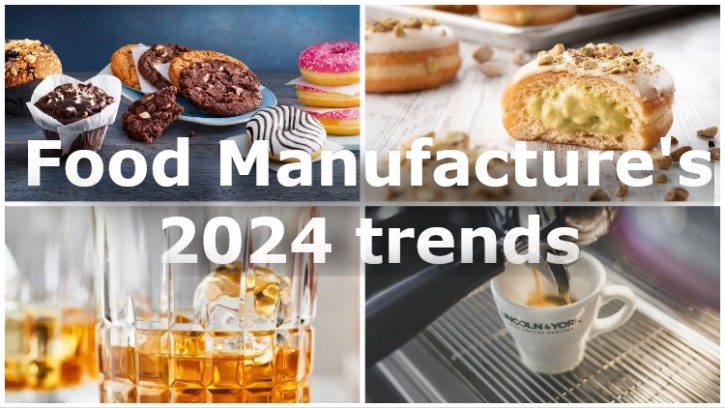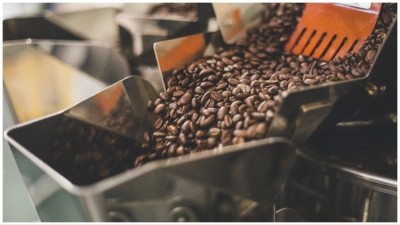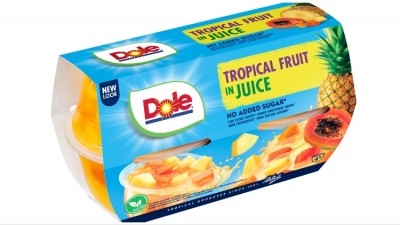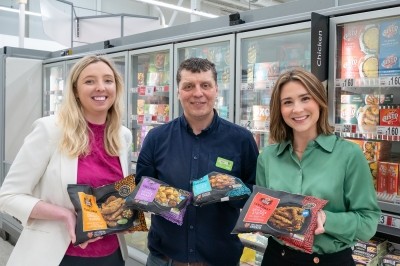Feature
The biggest food and drink trends of 2024

Happy new year! It’s January 2024 and as per tradition, Food Manufacture has curated a grandiose selection of industry experts to offer their predictions into what this year will bring.
Based on professional opinions and our own keen eyes, we’ve divided the biggest trends for 2024 into three overarching categories. Here’s what you need to be watching…
1. Flavours of 2024
In the ever-evolving landscape of food and drink, one way to capture attention is with new flavours.
During the pandemic, many manufacturers delayed innovation, and this caused the last year to witness a reduced level of new product developments – a 4.5% decrease according to the experts at NielsenIQ (NIQ).
However, as Mike Watkins, head of retailer and business insight at NIQ, told Food Manufacture, it’s crucial brands stay ahead of the curve by offering a range of diverse options, which includes providing consumers with new and dynamic flavour experiences.
Adventurous vs creature comforts
When it comes to flavours, consumers are becoming more adventurous.
Citing research from Innova’s latest Flavor Survey, Michael Schofield, Bakels Group’s marketing manager told us that two in three consumers are open to trying new global cuisines, with one in three in the Gen Z to Millennial age groups, looking for something a little different in their food and drink.
However, that’s not to say familiar comforts are going anywhere – in fact, 44% of consumers globally say that traditional and nostalgic flavours remain firm favourites.
“Looking at the UK specifically, just over one in four (26%) consumers are looking for something new and different, and one in five (22%) prefer exotic flavour combinations, but the data shows the rest of us want the familiar and comforting,” Schofield said.
“The nation’s top five most popular flavours for sweet baked goods are milk chocolate, dark chocolate, red raspberry, vanilla and chocolate chip. But orange, white chocolate, lemon, salted caramel, raisin, almond and strawberry are also gaining in popularity.
“Meanwhile, caramel is the taste of now, jumping to third place behind milk chocolate and strawberry in Innova’s ranking of seasonal and limited edition flavours, and fitting the trend of nostalgia and comfort foods, with the ability to elevate any sweet treat. But it’s also incredibly versatile – adaptable to new flavours, textures and within different formats.”
Dawn Foods’ marketing manager for UK and Ireland, Jacqui Passmore, agreed the big flavour trends for bakery this year are “very much about familiarity”, suggesting that ‘warming’ and ‘well-loved’ classics such as salted caramel, toffee, custard, citrus and gingerbread will be top of the list.
“While previously bakery flavours NPD has been very much about ‘blue sky thinking’, in this last year, Dawn has seen customers rationalise their thinking a little to focus on a few new flavours, such as Yuzu for example, which we believe will hit the mainstream next year,” she continued.
“In contrast, 2024 will see bakery manufacturers upscaling current formats to include new flavour versions or combinations rather than a bid to develop something more unusual. For example, we are seeing different flavoured doughnuts presented in the same format or cookies with different inclusions or iced buns with different flavour icings.
“Dawn’s Global Trends Survey, UK, 2022 found that 76% of European consumers enjoy sweet bakes that put a twist on a traditional item.”
Cautious with the pennies
Passmore attributed these trends to caution rising as a result of the cost-of-living crisis and the reality of high production costs.
“When times are tough, consumers tend to seek comfort in the familiar such as a nostalgic cake or dessert and in particular bakes that remind them of childhood. Indeed, according to the Mintel Flavour Survey UK 2023, ‘Retro Sweet’ is trending, with 37% of UK consumers saying that they like flavours that remind them of their childhood.
“Some raw material costs are increasing too and with this, in our experience, manufacturers and retailers alike are taking a slightly safer approach to R&D. Developing bakery products with more easily sourced ingredients and relatively conservative flavours to ensure both consistent supply and affordable price points.”
Passmore also pointed to bakery manufacturers continuing to keep their eyes on smaller, hipster bakeries for inspiration, with the likes of blonde chocolate and pistachio growing in popularity.
Tangy delights
IFF Nourish’s global product marketing leader, Cecilia Pereyra, meanwhile, predicts a big movement in the form of tangy flavours, with inspiration coming from global cuisines.
“Pickled foods and spices will continue to grow and evolve in food and beverages,” she added. “When it comes to global flavour trends, we can always know it will be about spice. Spicy, smoky, tangy flavours from regions all over the world are trending.
“Food producers will want to include these top-trending ingredients in food products – sesame seed, ginger, jerk, spicy honey, miso, and tahini.
“Korean and African flavours are most popular, with Italian, Japanese and Greek flavours trailing closely behind.”
Compleat Food Group’s Matthew McAuliffe mirrored Pereyra’s views, as he said he expects tangy, sour and salty to fare well this year.
“We are expecting an uplift in a classic favourite – pickled eggs – but with a higher quality, premium twist. For instance, paired with a quality balsamic vinegar, or beetroot infused vinegar to create a beautiful shade of pink,” he said.
Nutty and toasty notes
However, McAuliffe also pointed to another strong flavour profile to keep our eyes fixed on – nutty and toasty.
“Nutty and toasty is a flavour profile that is beginning to appear in existing well-known favourites like cookies and hummus, as it adds a greater richness and premiumisation,” he continued. “This is why we’re seeing a growth in the use of burnt butter. It’s added to foods to create a more complex, deeper, and nutty flavour and removes the fattiness that butter usually has.”
Alcoholic beverages
In drinks specifically, Jo Taylorson, head of marketing and product management at Kingsland Drinks, said the company is “confident vodka will continue to grow as gin consumers shift categories”.
She added that rum will remain “the darling at home” but it’ll have to work even harder as it makes room for darker spirits like whisky, while “tequila’s stronghold in the on-trade will start to very much take hold at home”.
She continued: “Our insights team expects to see Asian flavours such as yuzu, citrus notes such as pink grapefruit, and florals such as blossom, rose and hibiscus to come to the fore in 2024, coupled with a surge in new drinks launches containing well-known classic ingredients such as coffee, ginger, cherry, elderberry and mint, and smoky flavours in aromatic cocktails, ciders and spirits.”
In fact, “new and different” will be key for 2024, with these attributes considered as the biggest influence when buying alcoholic NPD, according to NIQ.
For vodka and gin, raspberry has emerged on top, claiming a 32.6% value share of the flavoured gin market and 41.2% of the flavoured vodka market.
“The rise of tropical and citrus flavours, such as passionfruit, mango, pineapple and blood orange is also notable across spirits, ciders and RTDs, highlighting the evolving preferences of consumers,” added Watkins.
While Natalie Sheil, European category manager for Synergy Flavours, believes “authentic alcohol flavours” will be big in 2024. This, she suggested, is particularly true for the low-and-no space as they seek a tasty replica to booze – and whilst ‘Dry January’ will drive these kinds of demands, Sheil said that alcohol reduction is not restricted for the start of the new year.
“Research conducted by the University of Sussex reports that even six months later, more than 70% of Dry January participants continue to make healthier beverage choices,” she said.
“These flavours are not exclusive to beverages either, and we expect to see alcohol flavours used across more applications in 2024. For example, Jack Daniel’s BBQ sauces have proven popular with consumers, and authentic alcohol flavours can be used in similar savoury applications such as sauces and ready meals to offer a unique flavour twist.”
The experts at ADM agreed, flagging a move towards a trend they described as ‘dare to dupe’.
“With consumers around the globe looking for affordable and authentic opportunities to replicate familiar tastes, the ‘#dupe’ trend has taken the food and beverage arena by storm. The word ‘dupe’ saw a 234% increase in daily Google searches over the past five years, signalling the concept is moving far beyond the label of product ‘knockoffs’. Consumers are also actively leaning on their memories to identify what ‘authenticity’ means to them, and they are open to the reinvention of nostalgic flavours in new and unexpected formats,” said ADM’s global product marketing senior director for flavours, Jennifer Zhou.
In addition to authentic alcohol flavours, Synergy is also anticipating that natural flavours will remain popular in 2024. “Natural cues still appeal to many consumers, with data from Innova showing that many consumers desire ‘authentically natural’ claims, such as ‘from nature’, ‘made from the real thing’ and ‘organic’.
“To appeal to these consumers, manufacturers can consider using flavours that can be depicted or called out on-pack as natural. Fruit flavours such as strawberry, raspberry and blackcurrant will always be popular, as will vanilla, so incorporating these into products as natural flavours, extracts, and essences will help manufacturers to both meet consumer preferences, and also keep costs down by reducing the need for the raw ingredient.”
Soft drinks and coffee trends
A similar ‘flavour story’ is happening within soft drinks, with preferences gravitating towards citrus, tropical and raspberry flavours; but to stand out in a saturated market Watkins believes we’ll likely see more unconventional profiles emerging. One recent example of this is Coca-Cola’s Sugar Byte, which invited consumers to explore what pixels might taste like.
“These ‘unreal’ conceptual flavours not only resonate with younger shoppers but also drive incremental growth by expanding the flavours repertoire of both existing and new consumers,” Watkins said.
This trend was echoed by ADM’s Zhou, who said that the rise of AI and other technologies has created way for what she described as the ‘phygital’ revolution – a clash of the physical and digital realms.
“AI is unveiling possibilities for transformative flavours and combinations, helping flavourists craft exciting flavour profiles that resonate with consumers' individual tastes and values,” she explained.
2024 could also be the year that more widespread use of coffee extracts and coffee concentrates come to the fore, as cold coffee becomes more popular.
Speaking with Ian Bryson, managing director at Lincoln & York, Food Manufacture was informed that while there are many iterations of coffee concentrates and methods of extraction, all produce a concentrated coffee essence which can be used in cold coffees to avoid brewing and chilling an espresso for every serve, without compromising flavour.
He elaborated further: “The popularity of cold coffee shows no signs of cooling off, with the iced coffee market currently valued at £178.9m – up 37% – meaning more suppliers across out of home and retail are looking for quicker ways to create high quality iced coffees and RTD products, including dairy-free alternatives.
“The use of coffee extracts not only speeds up service and guarantees consistency of flavour, it also enables businesses to grow and scale at speed, meaning its potential goes way beyond just cold coffee. This offers huge opportunities throughout the industry.”
Powerhouse ingredients in plant-based
As Food Manufacture reported towards the end of last year, FiE Frankfurt revealed that plant-based would keep a firm grip on the market, but we’ll see this category entering a new stage of maturity in 2024.
“In order to put taste first and improve perception of plant-based dairy, manufacturers need to be open minded when it comes to ingredients,” said Andrea Panzani, CEO at Valsoia. “Oats have emerged as a powerhouse ingredient, especially in the UK when it comes to plant-based frozen desserts, with approximately 27% of all European plant-based ice cream launches between April 2022 and March 2023 [containing this ingredient].
“This trend mirrors the broader shift in the plant-based milk sector, where oat milk has overtaken almond milk in terms of new product launches. However, in the quest for the best taste and texture, a more diverse range of base ingredients like cashews, soya, and almonds will create premium tasting products that will elevate the entire category, helping to shift perception of the category and elevate taste.”
Transform the processes of your food or beverage business
In a competitive food and beverage industry, staying ahead of your competition and having the agility to respond to market challenges is vital. Aptean’s range of industry-specific software, which includes purpose-built ERP, PLM, MES and more, help manufacturers, processors and distributors to increase visibility, transform processes and protect profit margins.
Our latest research into the trends and developments of the industry found that 93% of companies are already investing in cloud software solutions, like those mentioned above, to improve operations and replace manual processes. And with industry-focused software delivering 20% higher revenue, it makes business sense to find a partner who understands your sector and your specific requirements.
For more industry insights, download Aptean’s Industry Trends and Outlook Report now.
At Aptean, we know food and beverage. We have decades of industry experience and a family of robust solutions to help you take your business to the next level.
“Blonde chocolate will continue to trend, and pistachio is expected to appear in many forms such as smooth creams, textured fillings, or roasted to use as a topping. Future Christmases are likely to see an increase in French or Italian flavours, such as Frangipane, Panettone and Florentine, incorporated into British classics on assembly lines.”
But the popularity of the familiar will extend well beyond bakery, as Mike Bagshaw, founder of the flavour house I.T.S explained: “Thrift will remain a key driver in the forthcoming year and as the credit crunch continues, own label products will grow, meaning brands must work harder with innovation to keep consumer loyalty.
“Fresh formats that offer extra added experiences or value [will be popular], especially for 43% of 18–34-year-olds who say that they always take a photo for social when ordering a cocktail. A by-product of cost concerns will be a newfound interest in nostalgia not just in places and items, but in food products too. Consumers take comfort in the familiar when times are tough, nostalgia will continue to be big news both in flavours and format across all food categories.”
2. Health and functionality
Since the pandemic, health and functionality have been key selling points within food and drink. And, while the cost-of-living crisis remains a major concern for UK consumers, NIQ’s Watkins says the landscape is beginning to shift as consumers push health and wellness higher up the ranks.
“A staggering 84% of consumers feel it is important or very important to look after their household’s health,” he explained. “Notably, 97% of the UK population adheres to specific dietary habits, driven predominantly by the belief that such choices are ‘healthier’. Of those who follow a specific dietary habit, a third believe that a growing awareness of the relationship between nutrition and health overtime was the trigger to start eating in such a way. This realisation signifies a trajectory towards a more health-conscious consumer.
Healthy ageing
“When considering the motivating factors behind a healthy diet, longevity emerges as the main benefit. Consumers view a healthy diet not merely as a daily ritual, but as an investment in maintaining good health well into old age. This perspective is mirrored in the shopping aisles, where 44% of consumers agree that ‘health properties or the enhancing benefits’ of a product are important or very important when buying food and drink.
“Moreover, despite most of the population being affected by the cost-of-living crisis, there is a notable 17% of consumers who are willing to pay more for products offering specific health, diet, or added benefits – ranging from low sugar and low salt to added protein and sleep aids.”
Indeed, according to ADM, the five global consumer ‘asks’ include products that help boost immunity, digestion, heart and cognitive health, and mental well-being.
Gut health
Commenting further on this, ADM’s Vaughn DuBow, global director of marketing for microbiome solutions, highlighted the opportunity microbiome-supporting solutions could offer, with 58% of consumers globally connecting the function of gut bacteria to wider aspects of well-being.
“Prebiotics, probiotics and postbiotics are highly sought after across categories, as consumers connect them to a wide range of wellness benefits in products formulated to support gut health, immune function and weight management,” DuBow continued. “Specifically, postbiotics and spore-forming probiotics represent the next frontier of personalised nutrition, as these solutions can withstand harsh processing conditions, such as high-heat or high-water content, that may come with certain food, beverage and dietary supplement formulations. They are also enabling more convenient, tailored offerings, such as ready-to-drink (RTD) beverages, gummies, bars and snack clusters, that can easily fit into consumers’ busy everyday lives.”
Compleat’s customer insights director, Jason Fordham, agreed: “Knowledge of the importance of gut health has risen, and 7% of shoppers are now eating food to improve their gut health. This has brought fermented food and drinks to the fore and has led to an increase in sales for products like fermented condiments, such as kimchi and chilled pickles, which can easily be added to dishes to help consumers manage a regular intake of foods that do good for the gut.”
More and more protein
Synergy’s Sheil highlighted the opportunity here for the dairy category, with kefir growing in popularity as a result of its live cultures that promote gut health. But she also noted the trend for fortified dairy, in particular added protein.
“We’ve seen a growing interest in protein fortification, particularly in yoghurts,” said Sheil. In September 2023, Yoplait launched its new high-protein yoghurt that is also enhanced with vitamins B6 and D, available in strawberry & blackcurrant and mango & passionfruit flavours. In November 2023, Graham’s The Family Dairy also announced it would be stocking its Protein 22 pots in more UK supermarkets, and these are available in dessert-inspired Lemon Cheesecake, Chocolate Caramel, and Stracciatella flavours that position them as more indulgent treats.”
McAuliffe echoed her sentiments, as he told Food Manufacture that we’ll all be eating more protein in 2024: “No longer viewed as simply a necessity for fitness, protein’s ability to satisfy hunger and stop sugar cravings is becoming better known, and now 10% of shoppers are eating more protein.”
Mental well-being
But health is not focused solely on ‘what is good for our physical bodies’, it has also placed more emphasis on mental well-being and with that, consumer perceptions around sweet goods have changed.
“Enjoying something sweet every day has gone from ‘something I feel guilty about’ to ‘something that makes me feel good’,” explained Passmore. “According to Dawn’s Bakery Trends 2022 Survey, one in two UK consumers will try healthier sweet baked goods options and 61% of Gen Z consumers are willing to pay a slight price premium for more sustainable sweet baked goods, as well as for those products with a health claim.”
“When it comes specifically to snacking, shoppers now expect ranges containing some healthier options. In fact, for some time now we’ve seen a general snacking trend whereby more and more consumers no longer wish to consume ‘traditional’ snack items like crisps or chocolate bars and instead are actively seeking out something a bit healthier,” added Andrew Bradshaw, UK sales director at Dole Sunshine Company.
Natural ingredients and reformulation
Whilst consumers are taking a more holistic approach to health, natural remains a key trend for 2024 – with retailers and manufacturers remaining vigilant on natural ingredients used throughout production.
As such, we’ll see more companies highlighting on-pack claims like ‘no added sugar’ and ‘vegan friendly’, just as Dole Sunshine Company has planned to do on across its fruit in juice and fruit in jelly range.
“Tastes are changing and consumers demand less sweet,” added IFF’s Pereyra. “When decreasing sugar in their diets, more consumers prefer to reduce rather than replace with non-sugar alternatives or other flavours. Shoppers prefer less-sweet products over those that use non-sugar sweeteners or other substitutes.”
Baker & Baker UK R&D director Jon Adams’ thoughts echoed Pereyra’s, as he explained the focus has mostly been on ‘stealth health’.
“We don’t expect to see significant shifts in the health credentials of major in-store bakery lines,” Adams said. “Although we’ve noticed some HFSS-compliant bakery items enter the category, none have yet secured widespread appeal or sales.
“However, bakery manufacturers will continue their policy of ‘stealth health’ by incrementally removing sugars and fats from products without compromising on the quality or taste. This has been an incredibly effective tactic in improving health indicators in fresh bakery.”
3. Sustainability, trust and tighter supply chains
Although ‘natural’ and healthy foods will remain popular in 2024, these trends alone are no longer sufficient for consumers, in particular Gen Z.
Concurrently, we’re seeing several trends driven by climate and geopolitical uncertainty, namely localisation, eco-friendly practices and trust, all of which are dovetailed with a dash of scrutiny. In other words, consumers want to see companies making a difference but are also quick to question the authenticity of any claims made.
Putting your money where your mouth is
“Gen Z have grown up facing the harsh realities of climate change. They’re responding by supporting authentic, purpose-led brands and demanding that we move beyond sustainability to invest in people and planetary restoration,” said Maartje Hendrickx, market development manager at GNT Group. “It's clear that Gen Z consumers are serious about sustainability. They read the small print and are well-versed in calling out brands that don’t practice what they preach.”
Talking from his category's point of view, Lincoln & York's Bryson confirmed that "sustainable sourcing has never been more important" but not simply because of consumer demands and the impacts climate change is having on arable land (land suitable for coffee is predicted to decline by 50% between now and 2050 if nothing changes), but also as a result of new legislation coming into force.
With the new deforestation rules for example, companies are having to prioritise sustainable sourcing. Within coffee, like it has with many categories and their respective arena, this has led to some important research around climate resistant beans.
One product which could make an increased appearance in 2024, specifically, is Cascara.
"Often called the coffee cherry, Cascara is the skin and pulp of the coffee fruit. Traditionally discarded during the coffee harvesting process as a by-product, Cascara is now emerging as an exciting new option for consumers, as well as helping to strengthen the coffee trade economy by allowing coffee farmers to reduce waste and add income," explained Bryson.
"Cascara’s unique taste lies somewhere between coffee and tea. Whilst not as strong or rich as coffee, it’s full of fruity, slightly floral, and earthy notes whilst being packed with antioxidants and significantly less caffeine than coffee. With its sustainability credentials and added health benefits, plus a novel taste profile, Cascara is one to watch in the year ahead."
And it won't just be a case of climate resistant beans, 2024 will see more and more manufacturers looking to implement other ‘green’ tactics such as alternative energy to power factories and fleets. But the way in which this will manifest may be slightly different to 2023, as Tom Maidment, group product sustainability senior manager at Hilton Foods, revealed.
It’ll be more of a “test and learn approach” he told Food manufacture.
Expanding on this, he gave Hilton’s own plans as an example: “We’ve developed site level decarbonisation plans for all our sites and are implementing programmes for on-site solar generation, cooling system upgrades and factory efficiency, sharing learning between sites to maximise impact. By implementing real-time energy management, we can ensure we understand energy use at a site level, reducing our energy use, and consequently emissions, at each site, so we can learn what works best and apply that elsewhere.”
The year of ag-tech
Real-time insight will also play a role in agriculture, as AI helps to improve crop protection, soil health and crop yield.
“AI will unlock the power of AgriTech by optimising the ‘plant-business’ strategy, through better analysis of complex systems throughout the whole of the supply chain, helping to maximise productivity with improved decision-making by producers and empowerment of automation and robotics systems,” Natwest’s head of agriculture, Ian Burrow, stated.
He continued: “Robotics will continue to grow in the sector by developing more advanced and affordable mobile platforms with precise navigation and localisation that will allow the platform to be used with high precision in more demanding applications and terrain.
“Precision manipulation for harvesting and planting will continue to expand to other indoor/outdoor crops and consolidate current progress in berries and tackling labour shortages. Precision scouting will be key to detecting plant stress, pests/diseases and biodiversity index by using adaptive AI models that not only identify where there are problems in the crop but will also make recommendations on the best course of treatment as part of Integrated Farm Management. These systems will be integrated into a combination of fixed and mobile platforms and sensors to secure quality and yield in crops.”
Shorter supply chains
At the same time as agriculture tech is more widely embraced, we’ll also seeing localised and shorter supply chains continuing to prove a popular choice among producers, as climate targets edge nearer and geopolitical events highlight the need for self-resilience. In fact, Aptean’s latest food and beverage industry research found that increasing supply chain resilience is a priority goal for UK and Ireland companies in 2024.
“One key trend that is building in popularity is local sourcing with 35% of food and beverage companies planning to use more local suppliers in 2024, allowing them to avoid the variable costs associated with international shipping, improve their sustainability credentials by cutting food miles, and take greater control of their supply chain,” Aptean’s value creation leader for food and beverage, Joris Kolff, told Food Manufacture.
Paul Bradley, product marketing director at TraceGains aired similar thoughts as he explained the convergence of supply disruption and scope 3 emissions are driving brands towards local – or at least near-shore sourcing.
“Both those trends are pushing brands to rethink supplier relationships, either to create more efficient supply networks, or to seek new relationships entirely as products themselves change with the times,” he shared.
And while Roxana Chifericu, Raynor Food’s procurement manager agreed with them both, she noted the contradictions that have arisen as a result.
“There is an ongoing trend that we expect to see continuing into 2024 – a drive towards local sourcing in order to force down the total emissions in the life cycle analysis and generate resilience to supply chain interruption. However, there are contradictions that have arisen, for example where chicken sourced from Thailand has lower emissions than those sourced from the UK or tomatoes grown under High Power Sodium (HPS) lights in the UK have much higher emissions than those grown in Holland under LED lights.”
What trend will claim top priority in 2024?
It'll certainly be interesting to see how these trends evolve over the next year and whether we’ll witness any U-turns in 2024 as a result of new technologies, political change, or unanticipated flaws in what has already been mapped out.
But when it comes to the major trend drivers, such as health, expense, resilience and sustainability, these are realistically set to stick for some time. It’ll just be a question of what claims top spot – as we saw during Covid times, it was health; and more recently, cost. Perhaps this year, as I write these words during Storm Henk, it will be sustainability that triumphs – and if so, how will this influence flavours in the months to come? Definitely a topic to unpick later in 2024.



![Aptean-TrendsFeature-BoxOut[Jan2024]-optimized](/var/wrbm_gb_food_pharma/storage/images/_aliases/wrbm_medium/media/images/aptean-trendsfeature-boxout-jan2024-optimized/17048129-1-eng-GB/Aptean-TrendsFeature-BoxOut-Jan2024-optimized.jpg)


















